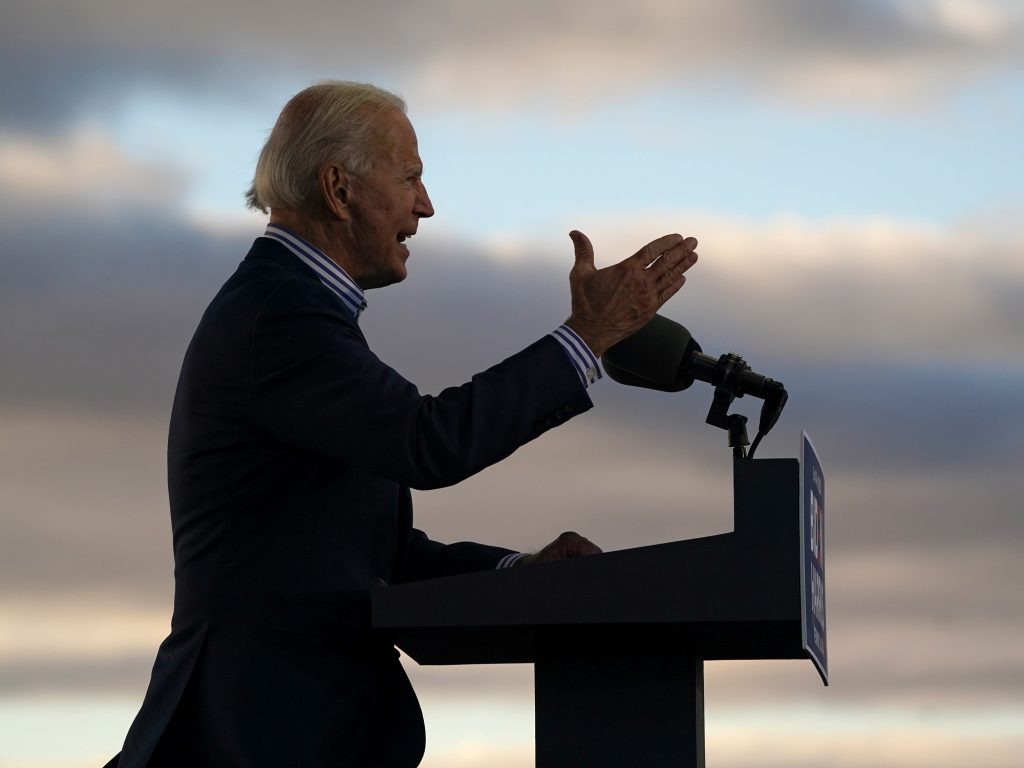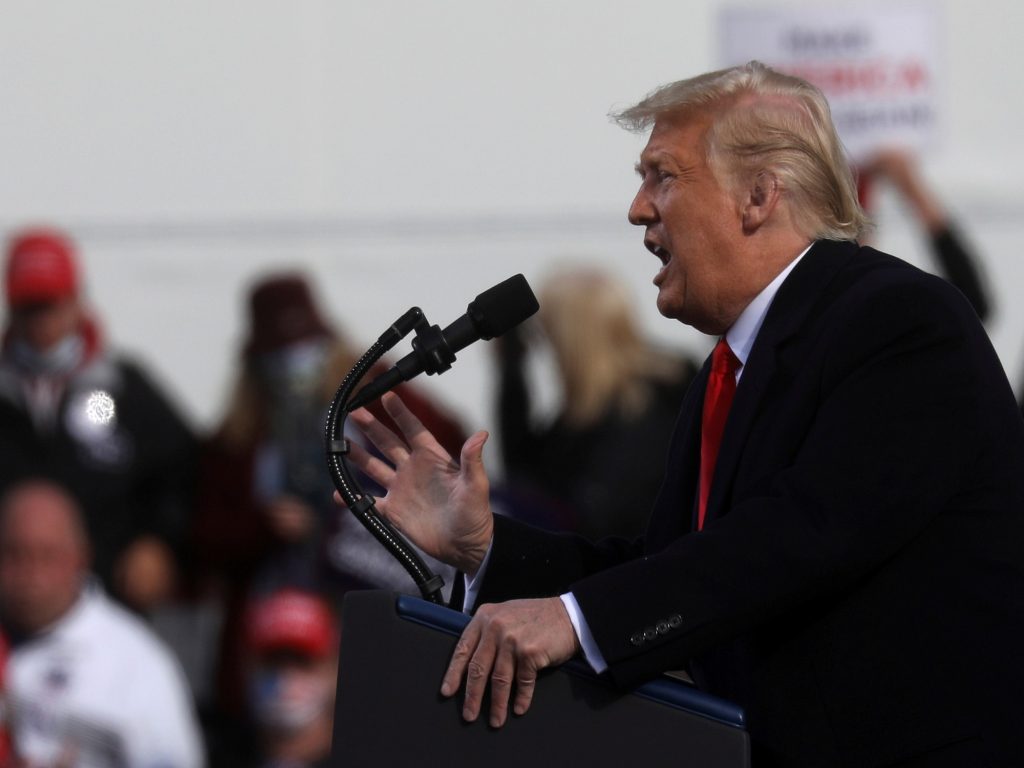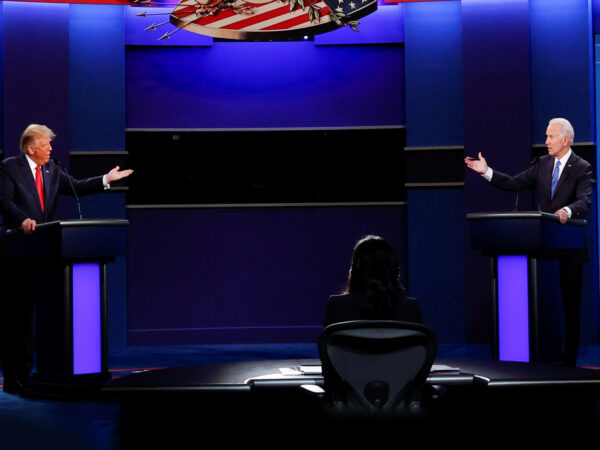This Issue Brief was co-authored by Ash Jain, senior fellow in the Scowcroft Center for Strategy and Security, and Barry Pavel, senior vice president and director of the Scowcroft Center for Strategy and Security. Gabriel Angelini, intern for the Scowcroft Center’s Global Strategy Initiative, and Daria Boulos, project assistant for the Scowcroft Center’s Global Strategy Initiative, contributed to this Issue Brief.
Introduction
The outcome of America’s presidential election will reverberate throughout the world. It will have a direct impact on US allies and partners, as well as structural implications for the global system. Will the United States continue to play its post-World War II international leadership role? Or will Washington continue its steady retreat from international commitments?
This Issue Brief will outline potential scenarios for US foreign policy after the November 2020 election. It will consider America’s role in the world in the event that Vice President Joe Biden wins the presidency, or if President Donald Trump is reelected to a second term. The paper will assess the candidates’ likely policies and the implications of those policies for US allies in specific issue areas, including: relations with allies, China, Russia, trade policy, and defense policy.
The bottom line is as follows. A Biden presidency is likely to result in a reaffirmation of a US commitment to democratic alliances, multilateral cooperation, and a rules-based international order. But America’s role in the world under a President Biden could play out under two different scenarios: one in which the United States adopts a proactive leadership role, galvanizing collective action with allies and partners, and one in which the United States is more restrained, focuses primarily on domestic issues, and leaves allies and partners with the responsibility to shape and address global concerns.
Meanwhile, a second Trump term almost certainly would mean a more unpredictable pattern of behavior for the United States on the global stage. Here too there are two potential scenarios: one in which Trump largely maintains the status quo, an “America First” approach that regards allies with skepticism and pursues greater unilateralism, and another in which Trump, no longer politically restrained, makes transformative moves on alliances, trade agreements, and other commitments that have underpinned America’s role in the world for the past seven decades.

Biden Presidency
As suggested by his record during four decades of public service, Joe Biden is an internationalist with extensive experience in foreign policy. As vice president, Biden was influential in shaping the Barack Obama administration’s foreign policy, from diplomacy and alliances, to trade and global economics, to defense and the use of military force. Previously, he served as chairman of the Senate Foreign Relations Committee and has long positioned himself as a proponent of NATO, free trade, and proactive US global leadership. However, while he appears inclined to pursue a more traditional form of America’s role in the world, Biden will have to considerthe views of the progressive wing of the Democratic Party, which is far more skeptical of US engagement, including military commitments, “forever wars,” and the benefits of trade and globalization.
Should former Vice President Joseph Biden win the election, his foreign policy could follow one of two paths: an America Engaged or what this paper refers to as Biden Restrained.
Scenario One: America Engaged
Under this scenario, a Biden administration would revert to a more traditional US foreign policy, committing to multilateral engagement, reenergizing alliances, advancing human rights, and promoting free and fair trade. The administration would seek to reposition the United States as a proactive global leader, working with allies and partners across Europe and the Indo-Pacific to take action on challenges from China to climate change. Biden would also look to rebuild sources of strength at home, including investments in infrastructure and technological innovation, which will help the United States strengthen its position to lead abroad.
Scenario Two: Biden Restrained
Under this scenario, a Biden administration would rhetorically affirm alliances and international engagement, but would take a less active posture on global affairs, and focus instead on domestic issues. While perhaps less likely than the first scenario, this scenario could play out if Biden feels constrained by a lack of public support for a proactive US foreign policy, which could result from a progressive wing of the Democratic Party in Congress becoming more influential. The imperative to focus on domestic challenges, from the pandemic to race relations to economic inequality, could prompt Biden to focus inward, especially early in his presidency. In this scenario, Biden would continue a gradual US retrenchment that began in the Obama administration, adopting a “lead from behind” approach, while expecting other allies and partners to fill the void.
Specific Issues
Under a Biden presidency, these scenarios could play out across a number of significant global concerns.
Relations with Allies
Under an America Engaged scenario, a Biden administration would reengage European allies and partners and seek closer cooperation. Biden has long been a proponent of a strong transatlantic relationship. From his time in the United States Senate to his term as vice president, Biden has repeatedly affirmed his support for NATO, viewing it as the most important alliance in the history of the world. On several key issues, he would seek to align more closely with European policy priorities (e.g., reentering the Iran nuclear deal and Paris Climate Accords). At the same, Biden would look to strengthen engagement with long-standing allies and partners in Asia, including South Korea, Japan, and Australia, and would look to forge closer relationships with rising democracies such as India and Indonesia. But, even as he pursues closer ties with allies, Biden likely would continue to push for burden sharing and greater allied commitments to defense spending.
Under a Biden Restrained scenario, Biden would likely offer rhetorical commitments to NATO and speak to the importance of maintaining strong relationships with allies and partners in Europe and the Indo-Pacific. However, the United States would be more reluctant to lead on global challenges, looking instead to European allies and partners to step up and take action. Biden would resist significantly strengthening NATO and America’s defense posture in Europe. He would maintain Trump’s troop redeployments out of Germany, and he might look to make other withdrawals as part of an effort to appease those on the left who are opposed to extended US military deployments overseas.
China
There is a bipartisan consensus that great-power competition with China is among the foremost challenges facing the United States and its allies and partners, and that a more competitive approach is needed. Biden has expressed concerns about the threat posed by China’s security, economic, and governance practices. Under an America Engaged scenario, Biden would continue to support a more competitive approach to China, but with three likely differences from the Trump administration. First, a Biden administration would seek to work more closely with allies to develop a coordinated approach to deal with China. Second, a Biden administration would likely take a firmer and more consistent line against Chinese violations of human rights, particularly in Xinjiang and Hong Kong. Third, even as it competes with China, a Biden administration would likely seek areas for engagement and cooperation, including, for example, on climate change and nuclear nonproliferation. Under this scenario, the United States would take a firm stand against China to address unfair trade practices, and would seek to work with allies to enhance cooperation on advanced technologies and more resilient global supply chains.
Under the Biden Restrained scenario, the United States would still look to work with allies to coordinate a common approach to China, but would be less assertive in imposing new actions to rein in Beijing, in order to avoid escalating tensions or risking any retaliatory actions by China that could have domestic economic repercussions. Instead, the Biden team would focus more on positive inducements, prodding and encouraging China to be a cooperative actor in the international system, and offering it a greater voice in multilateral institutions—much in the way the Obama administration approached the challenges of China.
Russia
On the campaign trail, Biden has called for more stringent measures to deter election meddling by Russian President Vladimir Putin, and has called for the creation of a 9/11 Commission-style inquiry into Russian attempts to influence US and allied electoral processes. Under an America Engaged scenario, a Biden administration would take a harder line against Russia. Biden would reaffirm commitments to NATO as a deterrent against Russia, maintain—and, perhaps, even strengthen—US sanctions on Russia due to its invasion of Crimea and eastern Ukraine, and work with allies to escalate pressure on Putin. At the same time, the most urgent priority with regard to Russia in a Biden administration would be to extend the New Strategic Arms Reduction Treaty (New START) arms-control agreement.
Under a Biden Restrained scenario, a Biden administration would seek to avoid any provocative actions, especially related to defense and military matters that could raise tensions with Russia. While it would still seek to hold Russia to account for its election meddling, the administration would adopt a more patient approach toward Moscow, maintaining sanctions to signal displeasure, but also initiating diplomatic entreaties in the hopes of producing a more stable relationship with Russia. This could include joining efforts by French president Emmanuel Macron to engage Putin and find areas of common ground.
Trade Policy
Under an America Engaged scenario, Biden would pursue an expansion of free and fair trade. Biden has been a long-time proponent of free-trade agreements. During his time as vice president, Biden led the Obama administration’s effort to create an Asia-Pacific trade deal, the Trans-Pacific Partnership (TPP). President Donald Trump withdrew from the negotiations in 2017 and, during the campaign, Biden indicated he would not join the follow-on accord (the Comprehensive and Progressive Agreement for Trans-Pacific Partnership (CPTPP)) as it currently stands. In this scenario, Biden would reverse this pledge after making adjustments to protect workers and the environment, and bring the United States into CPTPP. Similarly, on the transatlantic front, Biden would look to enter into trade negotiations with both the EU and the United Kingdom (UK), perhaps reviving the Transatlantic Trade and Investment Partnership, while reversing the Trump administration’s imposition of tariffs against US allies.
Under a Biden Restrained scenario, a Biden administration would likely face pressure from the progressive wing in Congress to avoid entering, or expanding, free-trade agreements. Instead, Biden would focus on policies designed to protect domestic manufacturing and jobs, which could lead to the continued use of sanctions to shield industries from the downside consequences of globalization. Biden would also pursue meaningful reforms to the World Trade Organization (WTO).
Defense Policy
Under an America Engaged scenario, a Biden administration would support a strong US defense and seek to avoid any significant cuts in defense spending. While he would support a continued drawdown of US troops from combat zones, Biden would maintain some level of military commitment in Afghanistan, Syria, and Iraq, perhaps with greater support from allies and partners. The administration also would recognize the need for the US military to begin to move away from its reliance on some traditional defense capabilities, and toward emerging technologies involving artificial intelligence, unmanned systems, space, and cyberspace. A Biden administration could seek to reduce spending on the nuclear-modernization program started under the Obama administration and continued by Trump, a program many Democrats view as wasteful and unnecessary. However, Biden was an advocate for regional missile defenses during his tenure as vice president, and can be expected to again press for additional US and allied capabilities in this area. Furthermore, under this scenario, Biden would seek to secure supply chains by both strengthening the United States’ industrial base and pursuing more closely integrated relationships with reliable allies and partners.
Under a Biden Restrained scenario, Biden would emphasize the need for humility in US attempts to use military power to shape international affairs. A restrained Biden administration would likely face pressure from Congress to enact more drastic defense-spending cuts, especially in controversial areas such as nuclear weapons and strategic missile defense. This would force the administration to make difficult choices about its defense priorities—which would likely be great-power competition with Russia and China—while being forced to scale down efforts in lower-priority areas, such as Afghanistan and the Middle East. Moreover, in this scenario, Biden could follow a more autarkical approach to defense industrial policy. There are indications that Biden could be more amenable to this view, as he has proposed a $700-billion “Buy American” campaign focused on boosting the US manufacturing and technology base. While this could help secure US supply chains, it would likely carry a high financial cost and could weaken relationships with allies and partners.

Second-Term Trump Presidency
A second-term Trump presidency would be highly unpredictable, given that President Trump’s personal views on America’s role in the world have been inconsistent and often in conflict with those of his own senior officials, many of whom have sought to pursue a more traditional US foreign policy. If President Trump receives a second presidential term, this paper envisions two potential scenarios, New Normaland Trump Unleashed.
Scenario One: New Normal
Under this scenario, Trump would maintain his “America First” approach to global affairs, in which he continues to downplay the value of multilateral engagement and alliances, while continuing to employ more assertive actions to contain China. Trump’s national security strategy would be marked by a narrow conception of national security interests, with an emphasis on great-power competition, unilateral action, sovereignty, and key favored relationships. Trump would continue to engage with global leaders who he personally finds appealing, including autocrats such as Putin, Kim Jong Un, and Turkey’s President Recep Erdogan. Still, in this scenario—like in Trump’s first term—the United States would continue to maintain a more traditional US foreign and defense policy, especially in areas where Trump is less directly engaged.
Scenario Two: Trump Unleashed
In this scenario, Trump would be emboldened by his electoral victory and gain an unprecedented sense of confidence, leading him to make more dramatic moves to carry out previous proposals to transform US engagement in the world and fundamentally alter the global order. With more loyal officials at the White House and other federal agencies, Trump would exert greater control over the levers of executive-branch power, as Republicans in Congress would be more deferential following his re-election. These bolder moves could include withdrawing the United States from NATO, ending treaty commitments with South Korea, Japan, and Australia, and reducing America’s military presence abroad, while seeking a new kind of strategic alignment with Russia. In addition, Trump could withdraw the United States from the WTO and impose more significant and far-reaching protectionist measures, particularly against the European Union (EU) and other US allies.
Specific Issues
This section considers what these two scenarios would mean for some of the largest areas of concern in the global community.
Relations with Allies
Under a New Normal scenario, transatlantic relations would continue to slowly deteriorate. Trump would see less need to coordinate policies with Europe, and would be more vocal in his disdain for traditional Western European allies, particularly Germany. While reluctantly maintaining support for NATO, he would continue to criticize allies for not meeting their two-percent spending commitments and sow doubts about Article V and the US willingness to defend allies in the event of an attack. While the United States and European allies would drift further apart, Trump would be receptive to a push for closer US-UK ties, at the expense of Germany and the EU. Trump’s unilateral and hardline approach to China also could alienate European partners concerned about maintaining their economic relations with China. At the same time, Trump would pursue stronger ties with allies in Asia, and continue to strengthen relations through the Indo-Pacific Quad, which includes Japan, Australia, India, and the United States.
Under a Trump Unleashed scenario, Trump could move forward to carry out his threat to withdraw the United States from NATO—a move he is contemplating if reelected, according to former National Security Advisor John Bolton. This would, of course, represent a dramatic rupture in transatlantic relations, leaving smaller European states vulnerable to Russian aggression. Trump would seek to follow through on his long-standing stated desire to pursue greater US strategic alignment with Vladimir Putin’s Russia. And, the Trump administration would look to impose new protectionist barriers on trade with Europe. In Asia, Trump would terminate the US-South Korea Free Trade Agreement (FTA) and withdraw US troops from South Korea, placing at risk alliance relationships with Australia and Japan.
China
Under a New Normal scenario, the Trump administration would continue its assertive posture on China, escalating competition with China across multiple domains. Despite often-positive rhetoric on his relationship with Xi Jinping, Trump has pursued a hardline approach toward China from the early days of his presidency, calling out China for its unfair trade practices and applying tariffs on billions of dollars of Chinese goods. The Trump administration would continue to defend against, and impose costs on, China’s threatening activities in the economic, technological, governance, and military domains, and ensure that the US military continues to underwrite a robust and effective deterrent posture vis-a-vis China in the Indo-Pacific.
Under a Trump Unleashed scenario, the US-China relationship would likely become much more confrontational, as Trump pursues a more aggressive effort to contain China. The United States could embark upon a more intense campaign of decoupling from China to protect supply chains and reduce economic vulnerabilities. A hard decoupling and a break in engagement with China could force other nations to choose sides. With a growing global bipolarity that stems from a deterioration of the US-China relationship, the global economy could bifurcate, and the prospect of armed conflict, potentially over Taiwan, could increase. While the United States may try to cooperate with allies and partners in a competitive strategy toward China, the Trump administration’s withdrawal from multilateralism and its emphasis on competition could severely limit efforts to work with partners. Conversely, a Trump unleashed, as dealmaker in chief, could seek a dramatic new trade deal with Xi Jinping that would result in a cooperative new relationship, not unlike what Trump would try to pursue with Russia.
Russia
Under a New Normal scenario, Trump would continue to maintain a positive personal relationship with Vladimir Putin. This would continue to mean avoiding any public criticism and seeking closer relations, including inviting Putin to join a Group of Seven (G7) summit in November (which he had postponed from earlier in the year), as a means to forge a broader coalition against China. At the same time, the Trump administration would continue to pursue tougher policies against Russia on the ground, such as, for example, its lethal aid to Ukrainian forces and its buildup of low-yield nuclear weapons. The United States’ continued presence in NATO would serve as a deterrent against Russian aggression, but Trump’s approach to Putin would raise uncertainties regarding whether the United States would be willing to act in the face of renewed Russian aggression in Europe. The New START arms-control agreement would be in jeopardy.
Under a Trump Unleashed scenario, Trump would seek a new strategic alignment between Washington and Moscow—made possible by US withdrawal from NATO—replaced by a new European security architecture that includes Russia. While it is unlikely that Putin would be interested in a genuine partnership with the United States, Putin would work with Trump to consolidate Russian influence and cement a fundamental shift away from a US-led global order. As in the previous scenario, part of this new alignment would include the renegotiation of New START and other arms-control treaties, and a drawdown of US conventional forces from Europe.
Trade Policy
In a New Normal scenario, Trump would seek to continue trade policies that are more protectionist in their orientation, designed to favor US domestic manufacturing and key industries important to Trump’s base. Trump’s second term could mean the imposition of more tariffs, particularly against Europe, China, Canada, and other nations that Trump sees as competitors, although Congress may limit his ability to maneuver in this space. At the same time, Trump would look to negotiate new trade deals, especially with the United Kingdom, building on his successful efforts to renegotiate trade deals with Canada, Mexico, and South Korea in his first term.
Under a Trump Unleashed scenario, Trump would look to make more radical moves on trade, including potentially withdrawing the United States from the World Trade Organization, which Trump has long criticized as weak on China and unfair to the United States. Similarly, Trump could pursue withdrawal from the US-Korea FTA, as he has threatened on previous occasions. Trump still might forge new agreements with countries or leaders that he views as friendly, including the UK. US economic policy in a second Trump term could be marked by a move toward autarky and economic mercantilism that would contribute to a worldwide regression on free trade.
Defense Policy
Under a New Normal scenario, Trump would seek to maintain US defense spending near current levels, and likely would emphasize a transformation of the US military from legacy systems to strategic capabilities and emerging technologies relevant for great-power competition. In 2019, President Trump conducted the first update of the US missile-defense plan since 2010, including provisions advocating for the use of new technologies and space-based systems. He also announced the establishment of the US Space Force to function as the sixth branch of the US military, and reestablished the US Space Command as one of the United States’ eleven unified combatant commands. The administration’s 2018 Nuclear Posture Review declared plans for the United States to develop the first new nuclear-weapons capabilities since the end of the Cold War. In a second term, Trump will likely increase investments in unmanned systems, artificial intelligence, hypersonic and intermediate-range missiles, directed-energy weapons, space, cyber, and missile defense. Trump’s approach to industrial policy may not be very different from Biden’s: securing supply chains; strengthening the US manufacturing and technological base; and maintaining an edge over China (or catching up where necessary) on key emerging technologies (e.g., artificial intelligence).
Under a Trump Unleashed scenario, US military commitments would be transformed, as the Trump administration would seek to withdraw from NATO and security treaties with South Korea and other allies. While defense spending likely would be maintained at current levels, Trump would follow an autarkical industrial policy that could weaken defense cooperation with key allies and partners overseas.
Conclusion
The outcome of the 2020 US presidential election will shape the future of the global order. The more likely scenario for a Biden presidency is America Engaged, given Joe Biden’s strong personal desire to restore the United States to a more traditional foreign policy posture. But, for either scenario, the United States would be interested in working closely with regional allies and partners to promote shared values, multilateral engagement, and a common approach to dealing with Russia and China. A Biden administration may also be open to new ideas for strengthening defense and technology cooperation with Europe and other leading democracies elsewhere. There is also good potential under a Biden administration for the United States and its democratic partners to work together on a new trade framework that could incorporate elements of the Transatlantic Trade and Investment Partnership, but also provide stronger protections for workers and the environment.
While a second-term Trump presidency could have a number of wild cards, the most likely outcome is a New Normal scenario, in which Trump maintains his “America First” posture, though with some efforts to make more transformative moves, such as regarding US relations with Russia. But, in either scenario, the United States would be eager to work with partners to address the China challenge and to help formulate a common strategic approach among leading democracies.
The outcome of the election will be hotly contested, especially if it is close, and the winner may not be clear for several days or weeks following the election. But, what is clear is that this will be a historic election, by any measure.
——-








Leave a Reply